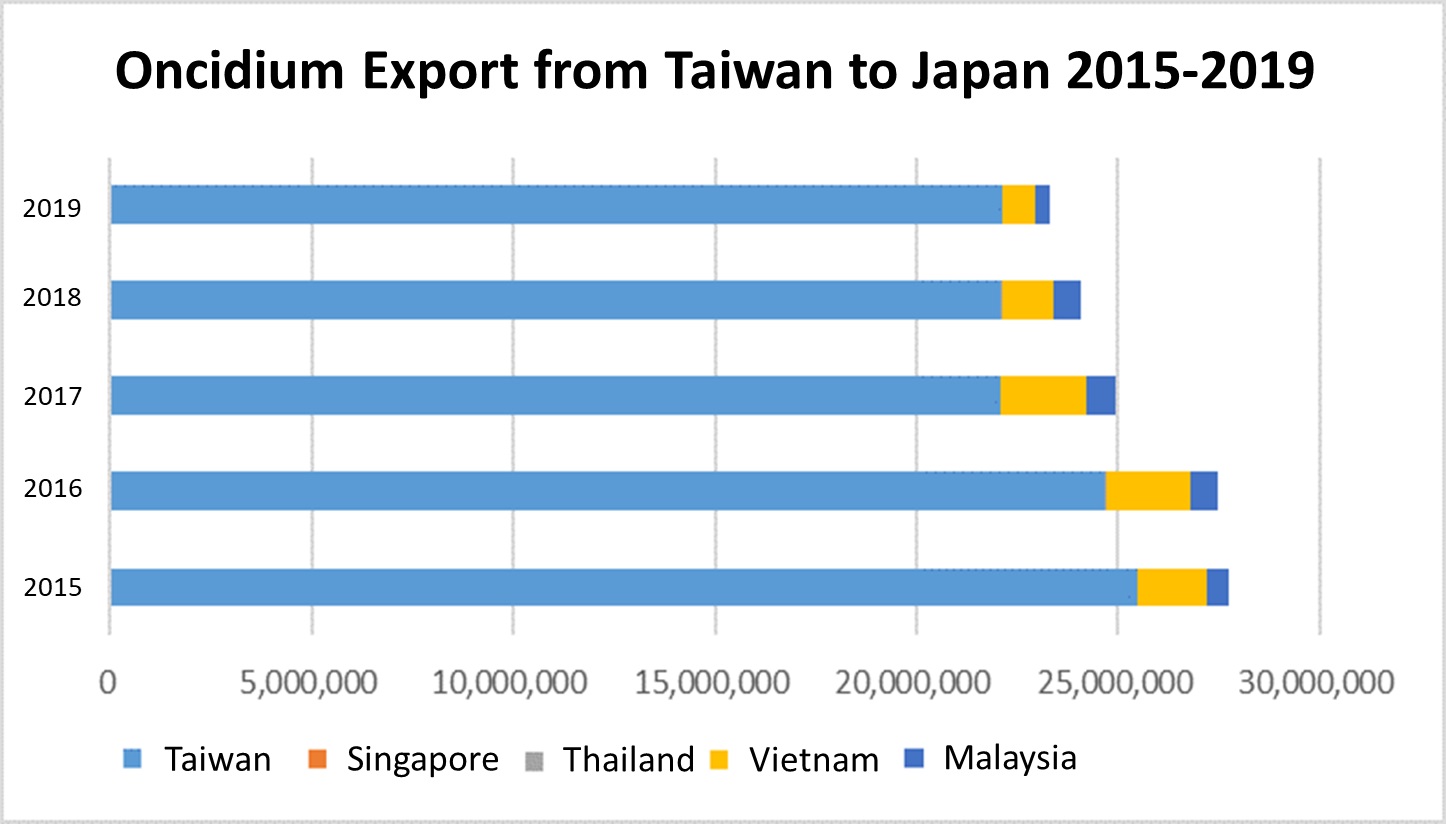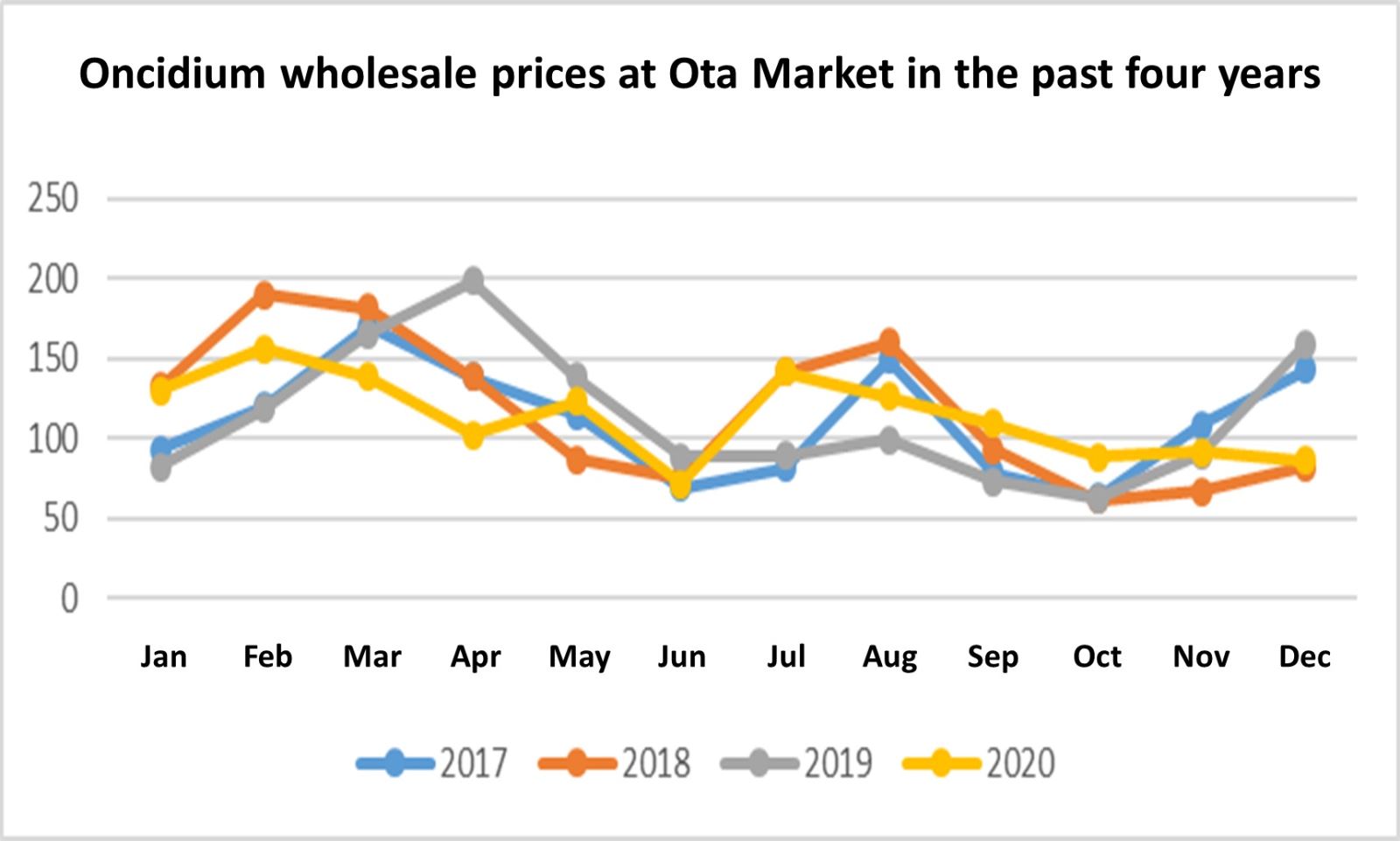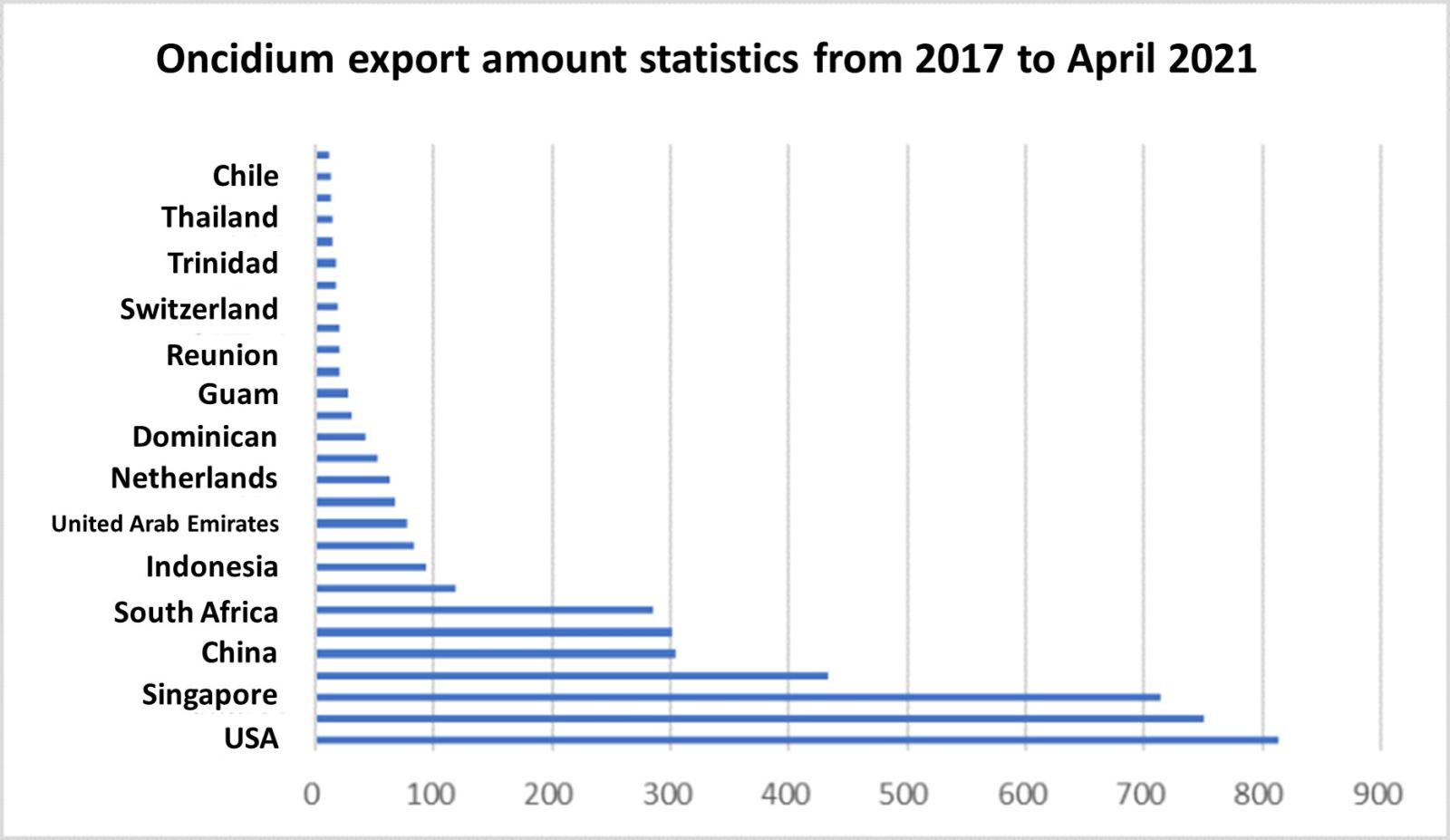Local Revitalization-- Strategic Alliance for Oncidium in the Post-Covid Era
YANG,CHAO-WEI(China Productivity Center Local Revitalization Business Group)
Oncidium is an aerial orchid native to tropical and subtropical America. Its origin includes Florida, Mexico, Central America, West Indies, Brazil, Peru, Bolivia, etc., grown on flat land up to mountainous areas 2,500 meters in elevation. Oncidium was introduced from Thailand in 1986 and has become a major flower industry in Taiwan, like Phalaenopsis. The planting area in 1991 was 10 hectares. After the test sales to Japan in 1994, the cultivation area has grown to more than 200 hectares in 2010 and to 379 hectares as of May 2021, based on the statistics of the Agriculture and Food Agency. The major cultivation areas are in Houli and Xinxhe of Taichung City, Gukeng and Dounan of Yunlin County, Dalin, Minxiong, Fanlu, and Meishan of Chiayi County, Changzhi, Ligang, Yanpu, and Neipu of Pingtung County. There are a total of 39 oncidium production and marketing groups. Operators of potted oncidiums are not many. Major ones are Green Valley Orchids Garden, Chian-Tzy Orchids Garden, Yongxin Orchids Garden, Guann Shin Orchids Garden and Taida Orchids Garden.
Taiwan's oncidium industry is mainly for export of cut flowers to the Japanese market. Since its trial marketing in Japan in 1994, the industry has undergone two major innovations. The first one was in 2000, when Dr. Huang Chao-Chia invented the preservation liquid TARI Oncidium No.1 solution to increase the life span of oncidium in vases and improve the preservation technologies, and replaced air shipment with sea shipment to reduce the cost of shipping. The sales volume of oncidiums has steadily increased from 10 million to 20 million stems.
The second innovation was in 2006, when flower farmers marketed the Japanese variety Oncidium Honey Angel and achieved the cut flower unit price of more than 300 yen in Japan. It was three times the price of the traditional cultivar Gower Ramsey. The rapid increase of the Oncidium Honey Angel quickly replaced the Oncidium Gower Ramsey variety. Export of oncidium cut flowers surged to 27 million stems. However, Oncidium Honey Angel farmers were charged of royalties up to JYP50 million per year. Private and COA-related research institutions were active in developing emerging local varieties, including Odontocidium Tariflor Snow White, which was bred by Tsai Tung-Ming, an assistant researcher then at the Floriculture Research Center of the Taiwan Agricultural Research Institute.
The variety right of Tainung No.4-Snow White was obtained in 2011, and in March 2013, passed the review of Japanese variety rights examination as the first oncidium variety from the public sector in Taiwan that has obtained the Japanese variety rights. Farmers of this variety are free from royalties in Japan. Thanks to the hard work of experts in industry and academia, 12 new varieties have been bred in the past three years and have received variety rights from the Agriculture and Food Agency. They are listed in the table below.
Oncidium variety rights certified in the past three years
|
Year |
Varieties |
Owners |
|
2019 |
Taichung No.4 Red in Snow |
Taichung District Agricultural Research and Extension Station |
|
2020 |
Apollo |
Chuang Chung-Yung |
|
Golden Sun |
Chou Tzu-Fu |
|
|
Panda Baby |
Chan Shih-Sheng |
|
|
Zhi-Xiang |
Chou Tzu-Fu |
|
|
Expectant Heart |
National Chung Hsing University |
|
|
Graceful Dance |
National Chung Hsing University |
|
|
Taichung No. 5-White Lady |
Taichung District Agricultural Research and Extension Station |
|
|
Jia Ho Queen |
Huang Wen-Jung |
|
|
2021 |
Chian-Tzy Dragon |
Yeh Yi-Chang |
|
HLD-Red Cherry |
Chang Fu-Lai |
|
|
HLD-Orange Fruit |
Chang Fu-Lai |
|
|
Izawa |
Liao Ping-Hung |
|
|
Elena |
Liao Ping-Hung |
|
|
Serena |
Chou Tzu-Fu |
|
|
Tainung No.8-Hua Mulan |
Tsai Tung-Ming |
(Data provided by Agriculture and Food Agency, edited by China Productivity Center)
Oncidium varieties with variety rights and are commercially produced and widely circulated include Tainung No. 4-White Snow, Tainung No. 7-Beautiful Girl, Apollo, Golden Angel, Izawa, HLD-Red Cherry, HLD-Orange Fruit, Panda Baby, Jia Ho Queen, Serena, Golden Sun, and Oncidium Honey Angel, the most popular one of cut flowers.
Oncidium Production and Marketing Groups by Counties in May 2021
|
Localities |
No. of Groups |
No. of operators |
Area (hec.) |
|
Taichung City |
14 |
255 |
135.99 |
|
Tainan City |
4 |
62 |
37.32 |
|
Kaohsiung City |
2 |
30 |
16.75 |
|
Changhua County |
3 |
45 |
27.1 |
|
Nantou County |
3 |
45 |
19.4 |
|
Yunlin County |
4 |
80 |
42.42 |
|
Chiayi County |
3 |
56 |
27.65 |
|
Pingtung County |
6 |
130 |
72.54 |
|
Subtotal |
39 |
703 |
379.17 |
(Data provided by Agriculture and Food Agency, edited by China Productivity Center)
As for the marketing challenges faced by the oncidium industry in Taiwan, the cultivation area of cut flower production and marketing groups is about 379 hectares, mainly distributed between Taichung and Pingtung, operated by 709 farmers. Recently the cultivation seems to concentrate in both Taichung and Pingtung, accounting for 60% of the production and the area space of the whole industry. The main production areas of oncidium in 2008 are located in Dakeng of Taichung City and Dalin of Chiayi County, accounting for 23 hectares. Houli Demonstration Zone in Taichung City was added in 2009 with a total of 64 hectares (three zones).
In 2010, five zones (84 hectares in total) were established at the main production area and additional six zones (112 hectares in total) were established in 2013, with an aim to introduce varieties of Taiwan Agricultural Research Institute, R&D results on preservation and cold chain technologies, and business diagnosis services, thereby improving the supply capacity and establishing a stable production and marketing supply chain with traders to improve international competitiveness.
Oncidium is mainly for export and many emerging varieties are engaged in competition. The yellow-flowered and white-flowered varieties are better received in the Japanese market. It is through a solid connection between the target market and emerging varieties that production can be maintained both in quality and quantity, to meet the needs of the overseas market. To form a strategic alliance for the oncidium export, the gradual development of a stable second market overseas are the current difficulties on which the oncidium industry needs to seek breakthrough.

Oncidium Export from Taiwan to Japan 2015-2019 (Data source: Customs of Japan, edited by China Productivity Center)
Although oncildiums from Taiwan still take up to 90% of the Japanese market, it can be seen from statistics that the import volume is declining, and the wholesale price of each stem is between JPY104 and 113. The overall market size shows a gradual downward trend year by year, and oncidiums from Vietnam and Malaysia have stable supply for 10% of the overall import volume. From the statistics, we can see that Japan is a stable and mature market. The development of new markets and the injection of vitality are necessary for further breakthrough of the industry.
Observing the output and market price of oncidiums, the high seasons of oncidiums are September to October and May to June every year. The output in these four months account for 40% of the annual production. The potential competitors in the Japanese market are Malaysia and Vietnam. Although the market share of Taiwan was as high as 92% in 2008, the prices fluctuate along with the Japanese wholesale market. For new breakthroughs, developing a stable second overseas market other than Japan has become one of the most important issues for the oncidium industry.

Oncidium wholesale prices at Ota Market in the past four years (Data source: Ota Market, Japan, edited by China Productivity Center)

Oncidium export countries from 2017 to April 2021 (Countries/value, excluding Japan)
(Data source: Agricultural Trade Statistics of Council of Agriculture, edited by China Productivity Center)
At present, 98.5% of oncidium exports from Taiwan concentrate on cut flowers, and the target market is Japan, accounts for over 95% of the export volume. The excessive concentration on a single market leads to the condition of the reliance on the wholesale price of the Japanese market as the indicator of the whole industry. The rising shipping costs resulted by the Covid-19 pandemic, the depreciation of the Japanese yens, the costs of labor and materials all cause great impact on the profitability of the industry.
The development of a second market other than Japan has become an urgent demand. Looking Asian markets, which are mostly at a short distance, Vietnam and mainland China are where Taiwanese operators mainly invest in cultivation farms for the export of tissue culture seedlings. For Asian markets within 10 days of sea shipment, South Korea, Singapore, Hong Kong, Indonesia, Macau and Malaysia are the major oncidium cut flower markets besides Japan. The second ring of markets includes Saudi Arabia and Australia. As for the potential markets using air transportation, we may consider the United States, Canada, the Netherlands, and South Africa. In April 2018, oncidiums from Taiwan successfully passed the quarantine of New Zealand and opened a new market there. This makes New Zealand and Australia potential markets for oncidiums.
The government policy now is to promote strategic alliances in conjunction with the marketing associations combined and the international trade system. Subsidies on intelligent energy-saving facilities are provided. At the same time, oncidium storage and packaging plants are chosen as regional center farms with facilities like seedling plants, green houses, supplementary lighting, and pesticide spraying systems, plus the improvement of the packaging cold chain facilities and fumigation operations.
The quality certification system is implemented for a standard operation process of post-harvest processing, including common grading, sorting, preservation, pre-cooling and shipping. This is done successfully, through the division of labor mode of strategic alliance, to effectively enhance the efficiency of industrial operation. Oncidiums usually have better quality in autumn, and farmers usually postpone the blooming season from September and October to December to February of the following year, with the quality of flowers enhanced through supplementary lighting.
In 2021, the Taichung District Agricultural Research and Extension Station implemented light supplementation at night six to eight weeks before harvesting and had the amount of A-grade flowers increased from 20% to 73.4%, which significantly helped increase the revenues of the farmers. The use of rail transportation equipment significantly saved time for pot-changing and cut flower harvesting by more than 10%. The technical industry-academia support continues with the experts introducing key techniques in seedling, cultivation, storage and transportation as an effort to develop secondary markets overseas. In the system of production and marketing, techniques of virus-free reproduction systems and post-harvest processing operations are introduced to the operators, including new varieties, preservation liquid, harvest period adjustment, and flower induction through lighting, MCP (1-methylcyclopropene) fumigation, and seaborne fresh-keeping technologies.
In the future, more consultation will be provided in conjunction with the Bureau of Agricultural Finance on agricultural loans for production and marketing facilities, and with the International Office for the development of the second or even the third market overseas.
The outbreak of the Covid-19 suspended many large-scale events and resulted in the surge in freight costs and a decrease in export orders for the oncidium industry, which suffered severe business conditions. Subsidy programs of the Agriculture and Food Agency include those on loan interests, staff salaries, export shipping costs, and fees of the wholesale markets. Revitalization measures such as flower exhibitions, flower breeding education, and flower consumption stimulation are also implemented.
On the part of the industry itself, the Chinese Development Association of Oncidium Production and Marketing launched fund raising measures to organize events such as exhibitions and flower design competitions domestically and abroad, which effectively stabilized export prices. Assistance on the improvement of packaging materials and on trial marketing effort overseas is also provided. Oncidium export to Japan from Taiwan decreased by 3.2 million stems in 2019 and 2020, reaching 14.5% of the annual amount. The Japanese market is also affected by the trend of otaku (home) economy and the shrinking demand for flowers in weddings and funerals. There are efforts paid to develop new flower breeding and new marketing channels like community subscription system, it takes time to witness the substantial effects to the industry.
The oncidium industry has undergone a total renovation, from the traditional production and marketing groups and cooperatives to the vertically integrated production model by 2022, deriving a market-oriented approach out of the previous production-oriented approach. There is a totally new philosophy. Measures like variety innovation, intelligent cultivation equipment application, introduction of cold chain technologies, gap filing in the value chain, and trial sales in the second overseas market are all on the way. The profitability is yet to see, but a new bight prospect of the overseas market development of the oncidium industry is in vision.